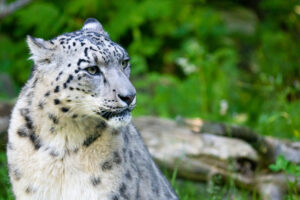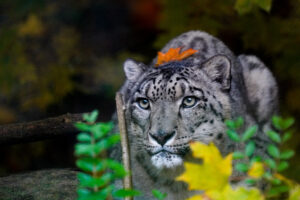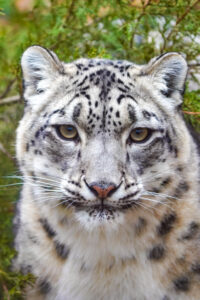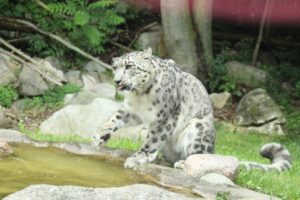SNOW LEOPARDUncia uncia
Conservation Status: Vulnerable
In the 1920s, about 1,000 pelts were traded in the fashion industry because of how popular they were. Their bones are also sought after for traditional Chinese medicine and farmers will kill them to protect their livestock. They are now protected by CITES (Convention on International Trade in Endangered Species). People are working to prevent hunting or retributive killing of the Snow Leopards and building habitat corridors.

Learn More
Color:
White with dark grey to black rosettes and spots. There may be a yellow tinge to the fur. They have long and thick hair (up to 5 inches thick), wooly belly fur, and large paws. It has shorter forelimbs and longer hind limbs that allow for greater agility in the mountains.
Size:
100-130 cm head and body length. Their tail is almost as long as their body and ranges from 80-100 cm.
Weight:
45-55 kg for males and 35-40 kg for females.
Average Lifespan:
10-13 years in the wild
Captive Lifespan:
18 years maximum
Central Asia. Most Snow Leopards are found in China, specifically in the Tibetan region, but they can also be found in Mongolia, Nepal, India, Afghanistan, Pakistan, Tajikistan, and Russia. They are found in the Himalayas.
Located in remote mountainous areas, they are found between 3,000-4,500 m in steep terrain with rocks and cliffs. They will live above the tree line in summer and may come down further in elevation during the winter.
Mating:
Early January to mid-March. They are polygamous.
Gestation/Incubation:
98-104 days
Litter/Clutch Size:
2-3 cubs
Mature:
Females reach maturity around 2-3 years old.
They are opportunistic predators that eat wild sheep, goats, occasionally livestock, and some small animals. A large animal is typically killed twice a month, but they will take smaller animals much more frequently. In captivity, they are given 2.5-3.5 lbs. of meat diet daily.
Snow leopards, like other cats, are solitary, although the home range of males and females may overlap. They use their large paws as snow shoes and their tails for balance. They will mark paths within their territory with claw marks, feces, and scent.
1. The tail is almost a meter long and thick. It is used for balance and is wrapped around the snow leopard for warmth.
2. The snow leopard can jump as far as 50 ft.
3. Snow leopards can kill prey up to 3 times their weight.
4. They have an enlarged nasal cavity that warms the air as it breathes in.
5. They can endure temperatures from -40oF to 104oF.
Our male snow leopard, Raj, was born at the Akron Zoo in Ohio on May 14th, 2012. Raj’s mother, Shanti, was born at Binder Park Zoo and later sent to Akron Zoo to breed with a male there. Raj was among her first litter of cubs born at Akron Zoo and was brought to Binder Park Zoo to replace Shanti, who continues to successfully breed in Ohio.
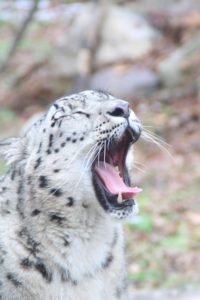 Raj loves Michigan’s winter weather and is well adapted for it: you’ll frequently see him playing in the snow. Snow leopards live in mountainous regions and are equipped for the cold and snow. They have very large widespread paws that increase their surface area, thus acting like snowshoes and allowing them to walk on top of the snow instead of sinking into it. They also have large bushy tails that they can use to wrap around their necks and faces to keep them extra warm.
Raj loves Michigan’s winter weather and is well adapted for it: you’ll frequently see him playing in the snow. Snow leopards live in mountainous regions and are equipped for the cold and snow. They have very large widespread paws that increase their surface area, thus acting like snowshoes and allowing them to walk on top of the snow instead of sinking into it. They also have large bushy tails that they can use to wrap around their necks and faces to keep them extra warm.
Victoria, our female snow leopard, was born June 5th, 2017, at Omaha's Henry Doorly Zoo and Aquarium. She arrived at Binder Park Zoo in August 2019 as a potential mate for Raj upon a breeding recommendation through the Species Survival Plan of the Association of Zoos and Aquariums.
Victoria is one of our hide and seek experts: Looking into her habitat, you may have to look very hard to see her because she blends in so well! She's always keeping a close eye on the surrounding area. She sees you before you see her. She's a super sneaky kitty!
Snow leopards are solitary animals, so Raj and Victoria rotate being in their habitat. Even though only one snow leopard is in the habitat at a time, they are not lonely. In the wild, snow leopards are typically only seen together during mating season or when a female has cubs.

